
|
|
|
|
|
|
Classic Bikes
Custom Bikes
Individual
Racing Bikes AJP
AJS
Aprilia
Ariel
Avinton / Wakan
Bajaj
Benelli
Beta
Bimota
BMW
Brough Superior
BRP Cam-Am
BSA
Buell / EBR
Bultaco
Cagiva
Campagna
CCM
CF Moto
Combat Motors
Derbi
Deus
Ducati
Excelsior
GASGAS
Ghezzi Brian
Gilera
GIMA
Harley Davidson
Hero
Highland
Honda
Horex
Husaberg
Husqvarna
Hyosung
Indian
Jawa
Kawasaki
KTM
KYMCO
Laverda
Lazareth
Magni
Maico
Mash
Matchless
Mondial
Moto Guzzi
Moto Morini
MV Agusta
MZ / MuZ
NCR
Norton
NSU
Paton
Peugeot
Piaggio
Revival Cycles
Roland Sands
Royal Enfield
Sachs
Sherco
Sunbeam
Suzuki
SWM
SYM
Triumph
TVS
Ural
Velocette
Vespa
Victory
Vincent
VOR
Voxan
Vyrus
Walt Siegl
Walz
Wrenchmonkees
Wunderlich
XTR / Radical
Yamaha
Zero
Video
Technical
Complete Manufacturer List
|
Ducati 1198SP
|
|
Make Model |
Ducati 1198SP |
|
Year |
2011 |
|
Engine |
Four stroke, 90°“L”twin cylinder, DOHC, desmodromic 4 valve per cylinder |
|
Capacity |
1198 cc / 73.1 cu in |
| Bore x Stroke |
106 x 67.9 mm |
| Compression Ratio |
12.7:1 |
| Cooling System | Liquid cooled |
| Lubrication System | Wet sump |
| Engine Oil | Synthetic, 20W-50 |
|
Induction |
Marelli electronic fuel injection, elliptical throttle bodies |
|
Exhaust |
Lightweight 2-1-2 system with catalytic converter and 2 lambda probes, twin stainless steel mufflers |
|
Ignition |
Digital CDI |
|
Starting |
Electric |
|
Max Power |
125 kW / 170hp @ 9750 rpm |
|
Max Torque |
131.4 Nm / 13.4 kgf-m / 97 lb-ft @ 8000 rpm |
| Clutch | Dry multiplate with hydraulic control slipper clutch |
|
Transmission |
6 Speed |
| Primary drive | Straight cut gears, ratio 1.84:1 |
| Final drive | Chain, front sprocket 15; rear sprocket 38 |
|
Gear Ratio |
1st 37/15 / 2nd 30/17 / 3rd 28/20 / 4th 26/22 / 5th 24/23 / 6th 22/25 |
| Frame |
Tubular steel Trellis frame |
|
Front Suspension |
Öhlins 43mm with TiN fully adjustable upside-down fork |
|
Front Wheel Travel |
120 mm / 4.7 in |
|
Rear Suspension |
Progressive linkage with fully adjustable Öhlins TTX monoshock with top-out spring. Aluminium single-sided swingarm |
|
Rear Wheel travel |
127 mm / 5.0 in |
|
Front Brakes |
2 x 330 mm Semi-floating discs, radially mounted Brembo Monobloc calipers, 4-piston, 2-pad. |
|
Rear Brakes |
Single 245 mm disc 2 piston caliper |
|
Front Wheel |
7-Spoke light alloy, 3.50 x 17 |
|
Front Tyre |
120/70 ZR17 |
|
Rear Wheel |
7-Spoke light alloy, 6.00 x 17 |
|
Rear Tyre |
190/55 ZR17 |
| Dimensions |
Length 2100mm / 82.6in Height 1100mm / 43.3in |
| Wheelbase | 1430mm / 56.3 in |
| Rake | 24°30' / 24.5° |
| Steering angle | 28°30' / 28.5° |
| Seat Height | 820mm / 32.2in |
|
Dry Weight |
168 kg / 370.3 lbs |
|
Fuel Capacity |
18 Litres / 4.75 US gal / 4.0 Imp gal |
|
Standing ¼ Mile |
10.2 sec |
|
Top Speed |
280.9 km/h / 174.5 mph |
| Road Test | IN MOTO |
Motorcyclists who want the ultimate streetbike that is track-ready
right from the showroom floor would most likely crave the 2011 Ducati 1198 SP.
The 1198 SP is an upgraded version of the standard 1198, with cutting-edge,
race-breed features.
Like the standard 1198, the 1198 SP arrives equipped with Ducati Traction
Control (DTC), Ducati Quick Shifter (DQS) and Ducati Data Analyser (DDA), but
the SP also features Ohlins TTX rear suspension, slipper clutch and lightweight
aluminum fuel tank.
The application of DTC to the 1198 SP underlines Ducati's intention to broaden
the use of tried and tested race-derived electronics to its high-powered range,
while the introduction of DQS marks the first time in history that "quick-shift"
electronics have been fitted to a production Ducati.
The 1198 Testastretta EVOluzione Engine
The Testastretta EVOluzione engine is the crowning glory of Ducati's development
and perfection of the L- Twin engine.
World Superbike dominance for almost two decades is the result of continual
commitment to their twin-cylinder configuration.
Ducati share the reward for that commitment with World Championship- winning
technologies constantly flowing from the factory race team into production
engines.
The incredible 1198 SP is powered by a liquid cooled, L-Twin, Desmodromic engine
that produces 170hp (125kW) @ 9,750rpm and a class-beating 97lb-ft (13.4kgm) of
torque @ 8,000 rpm. The 1198 SP achieves its capacity by using exactly the same
106 x 67.9 bore and stroke as the factory race bike.
Volumetric efficiency through the four valves per cylinder is optimized with
valve diameters at 43.5mm for the inlet and 35.5mm for the exhaust. They are
actuated by racing-type rocker arms, 'super- finished' for reduced friction and
fatigue, and double overhead camshafts with radical profiles.
The incredible valve performances achieved are only possible because of Ducati's
unique Desmodromic system, where valve closure is activated mechanically. At
high rpm it would be almost impossible for the valve to follow the steep closure
profile of the cam lobe if it were relying upon a normal valve spring.
With the Desmo system, the valve is closed mechanically with the same accuracy
as it is opened, enabling steep cam profiles and radical cam timings. This
system is used on every single Ducati motorcycle including their world-beating
Superbike and Desmosedici MotoGP bikes.
To keep Ducati's highly efficient Testastretta cylinder heads breathing to their
full potential, the injection system uses racing size elliptical throttle
bodies, which are an equivalent diameter of 63.9mm.
The race-designed 1198 pistons have a distinctive double-ribbed undercrown to
achieve high strength and reduced friction by using minimal piston wall surface
area. Using technology developed for the Desmosedici MotoGP project, the design
enables reliable operation of the 106mm diameter pistons when performing at high
rpm.
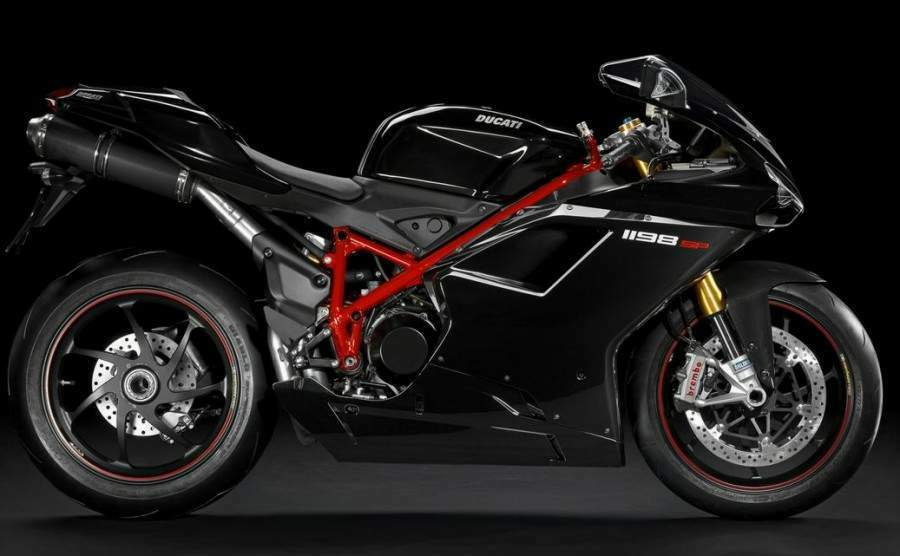
The 1198 Testastretta EVOluzione engines are the lightest ever used in Ducati
Superbikes, thanks to Vacural technology, a crankcase vacuum die-cast
manufacturing process yielding weight reductions of 3kg (6.5lbs) compared to the
first generation 1098 cases.
The vacuum die-cast process ensures consistent and precise wall thickness and
increased strength from absolute material purity. The weight-saving cam covers
in magnesium-alloy are evident by their gold color, while the alloy outer clutch
and generator covers sport a black finish.
The 1198 gears are machined from the same high-strength steel used in Ducati
Corse race applications and are subjected to a shot-peening treatment that
further ensures their strength and reduced fatigue.
Specifically for the track-ready 1198 SP, a dry, multiplate competition-style
'slipper' clutch is used to reduce the destabilising effect of aggressive
downshifting and to provide the fine control required during extreme corner
entry on the track.
The 1198 SP features a beautiful and efficient exhaust system. Incredibly
lightweight, it has been engineered with a power-increasing symmetrical 2-1-2
layout that uses 52mm-57mm diameter tubing with a wall thickness of 0.8mm
(.030in).
It is equipped with a catalytic converter and two lambda probes for optimum
engine mapping and Euro3 conformity. The system terminates with Ducati's
trademark twin under-seat silencers, delivering that unmistakable signature
sound of the big bore Desmo 90° L-Twin.
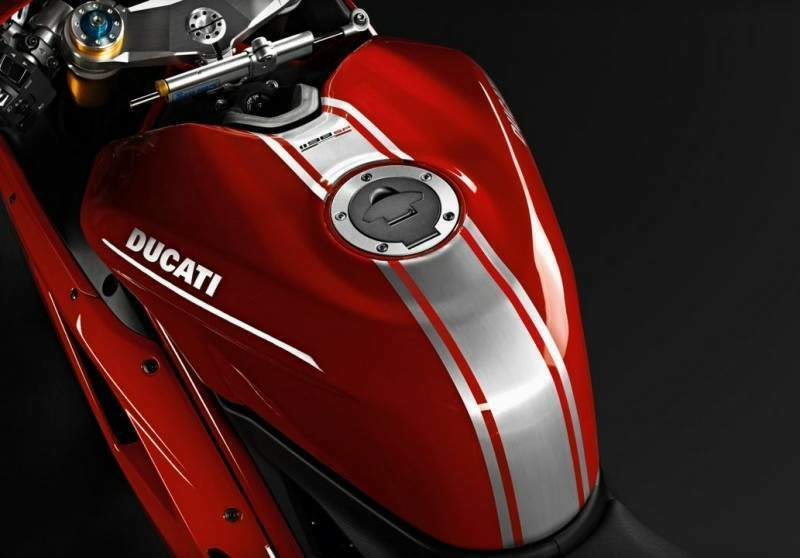
1198 SP: Pure Race Performance
Stunning 'SP' performance: the 168kg (370.3lb) (dry weight) 1198 SP creates a
dream package by taking everything that the 1198 model has, including DTC, DDA
and the new DQS systems, and adding top-of-the-range Öhlins suspension,
lightweight chassis components, a lightweight factory team-style aluminum fuel
tank and slipper clutch.
The high performance, fully adjustable 43mm Öhlins forks, which sport low
friction titanium nitride-treated fork sliders, respond effortlessly to every
imperfection in the tarmac.
Beyond their advanced engineering solutions, one of the most important
characteristics of Öhlins forks is their ability to communicate the condition
and quality of the tyre-to-road contact patch, a feature that puts every rider
in superior control.
The suspension set-up at the rear is complemented with a fully adjustable Öhlins
TTX rear shock equipped with a ride enhancing top-out spring and mounted to a
single-sided swingarm for outstanding drive and traction. The front-to-rear
Öhlins package is completed with a control-enhancing adjustable steering damper.
On any sport or race bike, the most effective area to reduce weight is its 'unsprung
weight'. These are components like tires, brakes and wheels. Lighter wheels have
a lower 'moment of inertia' that is beneficial with every direction change and
application of the brakes.
The 1198 SP addresses this important area by mounting 7-spoke Marchesini forged
and machined wheels. Both front and rear are super lightweight and their benefit
is immediately apparent. The weight saving is further enhanced with the
application of a carbon fiber front fender.
The 1198 SP weighs in at 1kg (2.2lb) less than the 2010 1198 S thanks to the
beautifully made lightweight fuel tank, which also boosts the bike's fuel
capacity by 2.5 Litres(0.66 US gal) to 18 Litres(4.75 US gal).
The tank is formed in 2mm thick aluminum, brush finished and then painted and
clear-coated to create a racing stripe of natural aluminum that accentuates the
factory race tank feel.
The 1198 SP is supplied with the Ducati Data Analysis (DDA), Ducati Traction
Control (DTC) and Ducati Quick Shift (DQS) systems as standard equipment.
The DDA package enables the retrieval and analysis of data collected from a
previous track session or road trip and DTC monitors front and rear wheel speeds
to detect rear wheel-spin under acceleration and electronically reduces engine
power to restore traction. DQS allows the throttle to remain open when
changing-up through the gearbox, helping to save vital seconds in the pursuit of
faster lap-times.
The 2011 1198 SP is available in two color schemes. The traditional Ducati red
is now supported by a new diamond black and completed with red Trellis frames
and black wheels with signature red pin-striping.
Ducati 1198 / 1198SP Features:
Engineered by the stopwatch
The 1198 SP Superbikes are the product of a team of designers and engineers who
have combined their Ducati MotoGP and World Superbike technologies to create the
finest sportbikes in the world.
From race-level engine specifications to World Championship-winning traction
control and quick- shift electronics, the results are pure excellence.
The Ducati Traction Control (DTC) system further confirms Ducati's technology
flow from racing to production and demonstrates how solutions developed for the
track can be applied to enhance safer performance on the road.
Designed by the race track
Ducati Superbikes are race bikes, pure and simple. Their striking aerodynamic
shapes create a natural riding position, confirmed by Ducati development and
factory team riders as the optimum for speed and agility.
Performance is first and foremost in every detail. Trademark Ducati features
like the high tail section and compact front end combine with twin under-seat
silencers and single-sided swingarm to express the sheer engineering beauty of
aerodynamics and agility.
Add the Testastretta EVOluzione engines as the hearts of the machines and the
result is all-out performance Ducati Superbikes that look fast even when parked.
Superbike Chassis
The 1198 SP chassis and suspension are the result of a 'performance-first'
priority approach to development, in which the goal is always to further reduce
weight and increase strength and rigidity to manage the high-powered
Testastretta EVOluzione engines.
Trellis Frame
Developed in cooperation with Ducati Corse, the lightweight Trellis frame
features 34mm main section tubes with a material thickness of 1.5mm. The result
is an incredibly rigid construction that remains one of Ducati's lightest frame
solutions ever. Adding style to performance, both schemes of the 1198 SP are
finished in red.
Front Suspension
The 1198 features spectacular 43mm Öhlins with low friction titanium
nitride-treated sliders are used on the 1198 SP. The front suspension solutions
have radial brake caliper mountings providing superior road holding and
incredible feedback to give every rider more confidence and control.
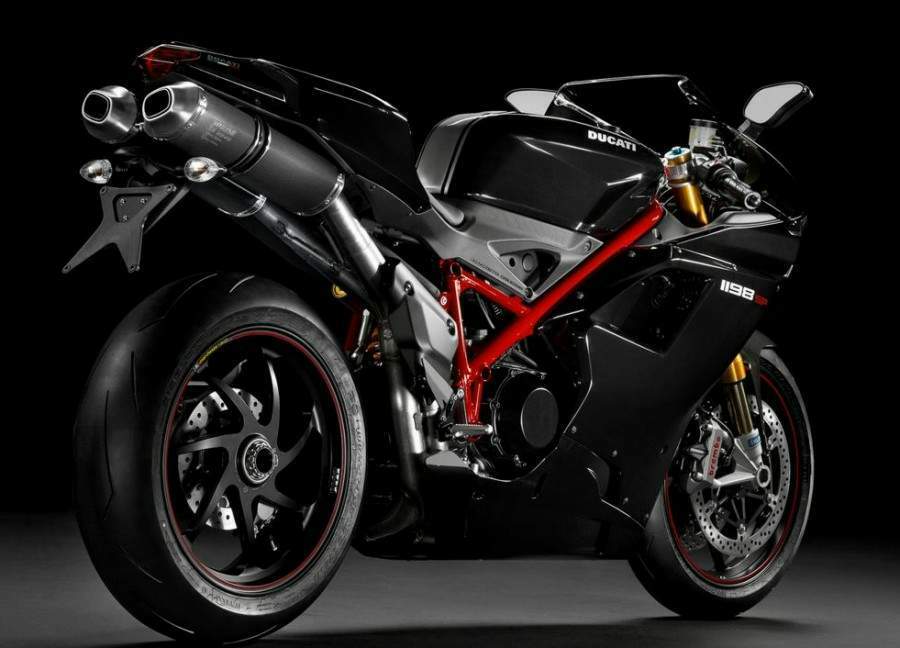
Rear Suspension
The lightweight Trellis frame and single-sided swingarm enable a compact and
weight-saving rear suspension linkage system that features separate lower
pick-up points for the push-rod and suspension unit. This 'tandem' design
effectively reduces stress around the linkage pick-up area of the Trellis frame.
Working together with this highly efficient linkage is an incredible Öhlins unit
for the 1198 SP with TTX twin tube technology providing totally separate damping
adjustment in compression and rebound.
The system uses experience gained in MotoGP to minimize friction and reduce the
risk of cavitations under extreme conditions. The 1198 and 1198 SP rear
suspension system has an adjustable rear ride-height, independent of spring
pre-load and other suspension settings - valuable when seeking the perfect
set-up for personal riding style or track conditions.
Single-Sided Swingarm
The dual construction technique used for the single-sided swingarm allows the
main operational components to use individual aluminium castings so as to ensure
strength around the pivot points, wheel hub and suspension links, while
lightweight, fabricated aluminium sections are used to complete the construction
into a single, beautifully engineered component. The 1198 SP all have single-
sided swingarms finished in black.
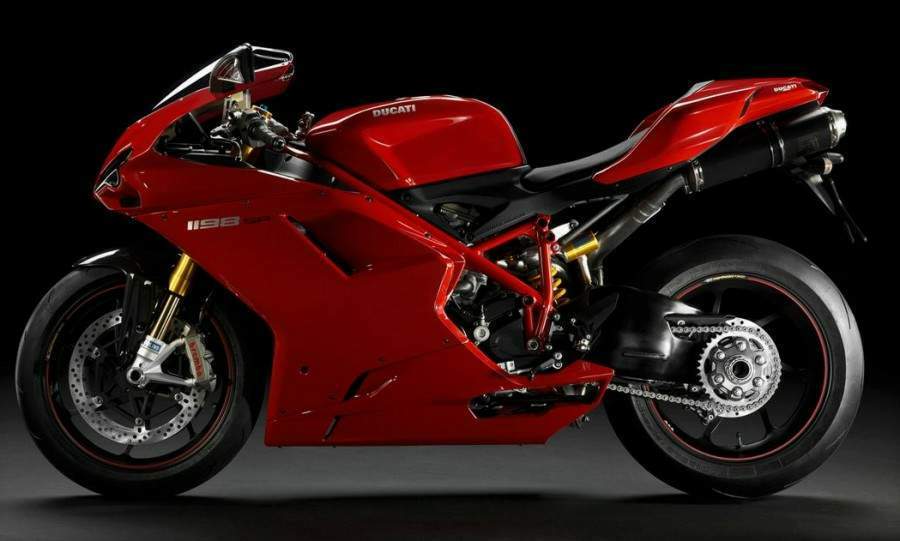
Race-Bred Brakes
Ducati Superbikes have always been famous for their incredible, track-derived
braking performance and the 2011 model line-up is no exception.
The 1198 and 1198 SP both use Brembo's incredibly powerful Monobloc caliper
racing technology. Machined from a single piece of alloy, the calipers achieve a
higher rigidity and resistance to distortion during extreme braking.
The resulting increase in hydraulic efficiency not only delivers incredible
braking power, but also provides an enhanced and precise 'feel' at the brake
lever. The twin Monobloc callipers each have four 34mm pistons that grip huge
330mm discs on the 1198 and 1198 SP to achieve spectacular braking performance.
Super Lightweight Wheels
The lightweight front wheels used on all Ducati Superbike models substantially
reduces the moment of inertia, enabling a faster change of direction and
enhanced acceleration and braking performances.
The 1198 SP goes to the next specification level by rolling out on beautiful
black 7-spoke lightweight, forged-aluminum, machine-finished wheels by
Marchesini.
The 1198 SP models are all fitted with Pirelli Diablo Supercorsa SP tires, at
120/70 ZR17 for the front, and 190/55 ZR17 for the rear of both 1198 models.
These high-performance tires have shoulder areas that maximize the contact patch
and carcasses specially designed for stiffness under heavy braking and precision
during high speed cornering. This precision in tire construction enabled Ducati
technicians to create extremely fine programs for the Ducati Traction Controls
systems used on the 1198 and 1198 SP.
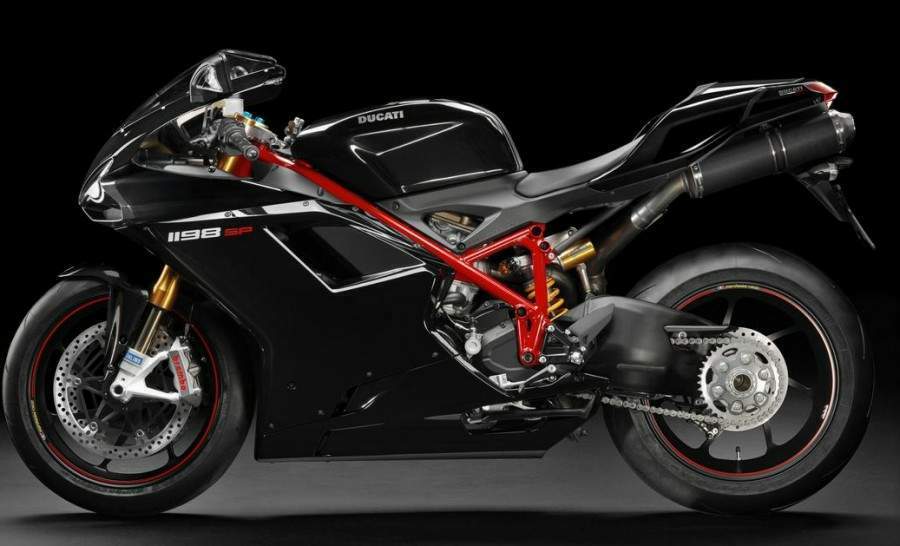
Magnesium Subframe
Producing a front subframe in magnesium underlines the attention to
weight-saving detail in the Ducati Superbike range.
Its construction provides secure support for the headlamp, instruments and
fairing, and the weight-saving around this high, forward position contributes
considerably to overall 'feel' and control of the machine.
Aerodynamic Bodywork
Carefully designed for aerodynamic efficiency and to hug the sleek lines of the
chassis, the Superbike bodywork enables the rider to blend effortlessly into the
correct riding position.
Its race-developed fairing design ensures perfect integration with the cooling
system by providing efficient flow through the advanced, large surface area
coolant radiator, which is assisted by lightweight, high flow electric fan
assemblies and oil coolers.
Aerodynamically shaped air ducts positioned just below the headlamps are
precisely calculated to provide ample air delivery to the pressurized airbox.
The lightweight bodywork contributes considerably to overall performance by
reducing weight, protecting the Testastretta EVOluzione engine's power output,
and assisting the rider to effortlessly 'tuck in' from the wind stream and
reduce drag to achieve maximum straight-line track speeds.
Instrumentation
This pure racing digital instrumentation originating from Ducati's MotoGP
project has no switches or buttons to compromise its clean, minimalist lines.
Instead, information additional to the default read-outs is managed from the
left-hand handlebar-mounted switch gear, allowing the rider to scroll through
and select from various menus.
The display, which has a bright white LED back lighting presents rpm and speed,
with the former displayed across the screen in a progressive bar graph.
Optionally, the rpm and speed can be displayed in numeric values.
Additionally, it displays lap times, DTC level selected (if activated on 1198
and 1198 SP) time, air temperature, coolant temperature, battery voltage, two
trips and a trip that automatically starts as the fuel system goes onto reserve.
Warning lights illuminate to signify neutral, turn signals, high- beam,
rev-limit, low oil pressure, fuel reserve, DTC intervention (if activated on
1198 and 1198 SP) and scheduled maintenance.
The instrument display is also used as the control panels for the DDA (supplied
as standard equipment with the 1198 and 1198 SP), DTC and DQS systems as well as
listing lap times recorded by using the high-beam flash button as a stopwatch.
Superbike Lights and Indicators
The horizontal twin headlamps, a signature Ducati style from the iconic 916, are
modernised with the latest lighting technology. Two polyellipsoidal units light
the way with a powerful beam while maintaining an aggressive look to the front
of the machine in pure Ducati Superbike tradition.
The rear light employs a specially designed strip of LEDs enhanced by a high
diffusion lens shaped into the sleek lines of the tailpiece. The same LEDs are
intensified for brake lights.
The directional indicators also use the latest in LED technology for
illumination. The frontal indicators are beautifully integrated into the rear
view mirrors, which come with an optional spacer kit enabling an extension of
30mm over the standard mirror stem length.
Ducati Quick Shift
The Ducati Quick Shift (DQS) system is the first time that a race-style
electronic quick-shift has been supplied as original equipment on a production
Ducati. Normally used specifically for racing, the system allows the rider to
keep the throttle open when changing-up through the gearbox, helping to save
vital seconds in the pursuit of faster lap-times.
The system not only saves time when changing gear, but also enables the
possibility of uninterrupted air flow through the throttle bodies throughout the
upward gear- changing process.
The system consists of a micro-switch built into the linkage of the gear change
lever, which when actuated in the direction of selecting a higher gear, sends a
signal to the main ECU.
The ECU instantly understands which gear the motorcycle is in by calculating the
rpm and vehicle speed and then reads the amount of throttle opening before
applying a pre-programmed cut in fuel injection and ignition measured in
milliseconds.
This spilt-second electronic interruption in drive is programmed precisely to
allow the next gear to be selected without having to actuate the clutch or close
the throttle.
The DQS system can be deactivated by entering the control panel in the
motorcycle's instrumentation and is reactivated by default the next time the
ignition is turned on.
As the system only functions for a matter of milliseconds, the 1198 and 1198 SP
can still be ridden using a normal gear-changing style.
Ducati Traction Control
Ducati were the first manufacturer to introduce a true competition-level
traction control system on a production motorcycle and for 2011 the highly
successful system is now integrated into both the 1198 and 1198 SP electronics
as standard equipment.
The Ducati Traction Control (DTC) system further underlines Ducati's technology
flow from racing to production and demonstrates how solutions developed for the
track can be applied to enhance performance safety on the road.
DTC uses the same software logic developed and used by Ducati Corse for their
World Championship- winning MotoGP and World Superbike motorcycles and offers a
choice of eight settings developed by their professional test riders and racers.
Accessible from the left-hand switchgear and displayed on the digital
instrumentation, the system offers a choice of eight profiles, each one
programmed with a wheel-spin tolerance matched to progressive riding levels of
skill graded from one to eight.
While level eight administers a confidence-building, high level of interaction
from the system by activating upon the slightest amount of wheel-spin, level one
offers a much higher tolerance and, therefore, much less intervention for highly
competent riders.
When the level is selected and DTC activated, the level is displayed on the
instrumentation.
When the profile that best suits the combination of road or track conditions and
riding style has been selected and the DTC system activated, front and rear
wheel sensors compare speed differential to sense when rear traction is being
broken (wheel-spin).
DTC then decides the best combination of two different types of instant
electronic adjustment, calculated with data supplied from multiple sources.
The first 'soft' stage of system interaction is executed by high speed software
that makes instant electronic adjustment to the ignition timing, administering
varying amounts of ignition retardation to reduce the engine's torque.
During this initial stage of DTC interaction, up to three red lights - normally
used to signify the over-rev limiter - illuminate to indicate the amount of DTC
being applied.
If the DTC software detects that the first 'soft' stage of system interaction is
inadequate to control the wheel-spin, it continues to administer ignition
retardation and, in addition, instructs the engine ECU to initiate a pattern of
constantly increasing injection cuts until, if necessary, full injection cut.
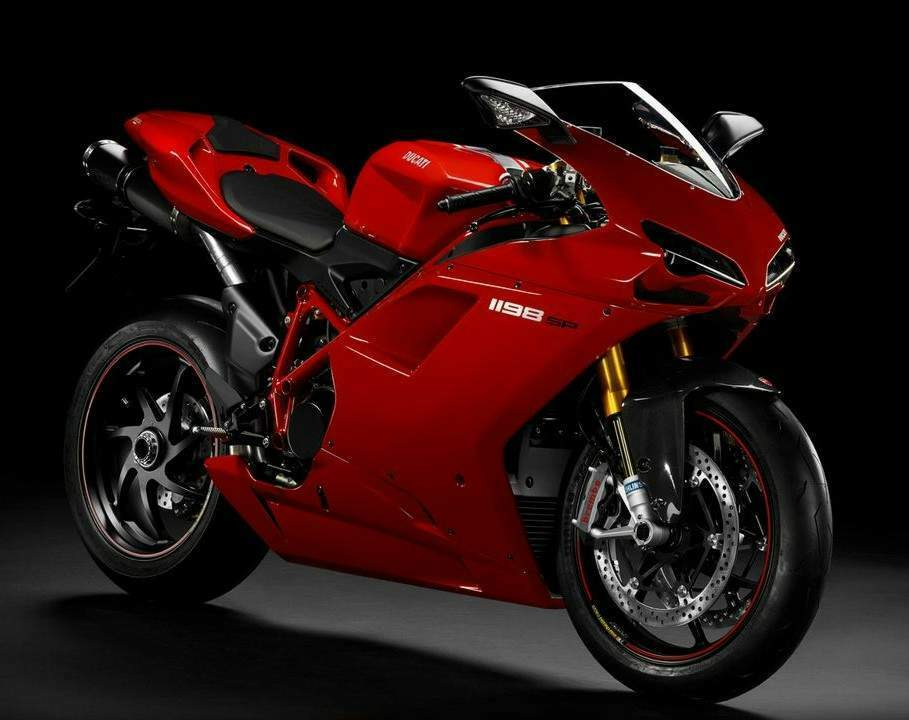
During this second stage of interaction, all four warning lights fully
illuminate to signify that DTC has also initiated injection cuts. As soon as the
system recognizes the gradual return of equal wheel speeds, it incrementally
re-establishes normal power delivery. This seamless interaction is key to the
super-smooth operation of the system.
The real innovative thinking behind the DTC system is how the various range of
sensitivity levels decide precisely how to react to excessive wheel-spin by
understanding the bike's exact 'dynamic situation'.
From slow mid-corner acceleration with considerable vehicle inclination to high
speed corner exits while almost upright, this 'system intelligence' is achieved
by processing a mass of data in a matter of milliseconds. This technology exists
thanks to the thousands of laps and hours spent testing, programming and earning
Ducati Corse race victories on the track. It represents just part of Ducati's
latest road-bike technology and provides considerable increase in performance
safety during mid-corner acceleration.
Data Acquisition
The Ducati Data Analyser (DDA) - complete with PC software, a USB-ready data
retrieval card and instructions - evaluates the performances of the bike and its
rider, and makes comparisons between various channels of information.
Normally only available on race bikes, DDA records numerous channels of data
including throttle opening, vehicle speed, engine rpm, engine temperature,
distance traveled, laps and lap times.
The system also automatically calculates engine rpm and vehicle speed data so as
to display gear selection as an extra channel of information.
An additional channel of information is now dedicated to recording the DTC index
which can then be viewed as a graphic trace and indicates the amount of DTC
interaction during wheel- spin.
At the end of a ride or track session, an upgraded 4mb of data can be downloaded
to a PC ready to compare, analyze and get an inside view of the performance of
the rider and motorcycle.
Data can be analyzed in graphic form with options to zoom into detail of
specific sections. Dragging a trace along a timeline to reveal individual values
of the above listed channels enables the user to analyze performance in the same
way that data technicians can in factory teams. The software allows data to be
compared with that from a completely separate session and for pages of data to
be printed off easily.
|
Any corrections or more information on these motorcycles will be kindly appreciated. |